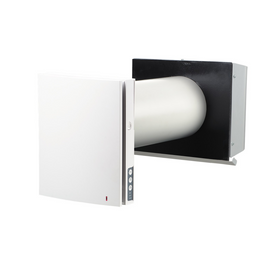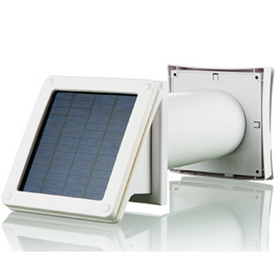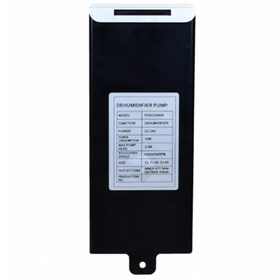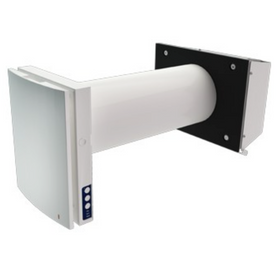
How to Cool Your Home Without an Air Conditioner
Last Updated: Feb 26, 2025While the first warm spells of spring are probably enticing you to open up your windows and let in some of that natural warmth, it will not be long before those long, hot summer days are beating down on your home and you're trying everything in your power to keep the sun away. You can consider investing in some automated window shades that can help you keep that unwanted summer heat from your home. But, there are other, more natural ways to help keep your home comfortably cool - without relying exclusively on the air conditioner. These methods are often referred to as natural ventilation, which you can read all about in our recent guide.
Many homeowners make landscaping choices based on how pretty the flowers look. But, the plants, bushes, and trees that you plant around your home can serve several other important purposes. Homeowners have used landscape shading for hundreds of years. Long before the days of centralized air conditioners, a pair of pruning shears was the primary tool for helping to keep homes cool during those long, hot days of summer.
This article offers a complete rundown on how the landscape vegetation you choose for your property can provide helpful shading options with numerous sustainability benefits.
Table of Contents
- The Cost of Air Conditioning
- How Can You Cool My Home Naturally?
- What Trees Offer the Best Shade?
- Knowing the Sun
- What Are the Benefits of Exterior Shading?

The Cost of Air Conditioning
Whether we want to believe it or not, climate change is here. It will continue to affect weather patterns across the world dramatically. While climate change was directly responsible for the 2019 Polar Vortex that dropped temperatures to Arctic levels across the Midwest, it will also bring higher temperatures and more intense heat waves. Studies have shown that heat waves across the United States are increasing in frequency and intensity. The United States only experienced an average of two heatwaves per year during the 1960s. That number has tripled to more than six per year during the 2010s.
More concerning still is that the average heatwave season across 50 major cities is 47 days longer than in the 1960s. The US Center for Disease Control and Prevention recently presented evidence that heatwaves across the country were responsible for over 600 deaths each year.
Air conditioning is one way to stay protected from triple-digit temperatures in the summer. It will continue to be a necessary aspect of homes located in areas where heat waves hit regularly. However, reliance on air conditioning to keep your home's indoor temperature comfortable also comes with an enormous ecological cost. According to the United States Department of Energy, three-quarters of the US's homes own air conditioners. These appliances use about six percent of the total electricity produced in the US and cost homeowners an astounding $29 billion. About 117 million metric tons of carbon dioxide are emitted due to their use each year.
One of the best approaches to reducing the carbon footprint of cooling a home is opting for natural shading strategies, which we explore below.

How Can You Cool My Home Naturally?
Natural shading strategies will largely depend on your geographic region, orientation, surrounding buildings and homes, and other contextual factors. The landscape design for a home located in the Upper Peninsula of Michigan will be radically different from that in New Mexico. Nonetheless, you can universally apply some principles and approaches.
First, you will want to prioritize areas around your home with windows. While outdoor heat can enter a home through walls, windows are especially susceptible to unwanted heat gain. Planting on evergreen and deciduous trees chosen for your region are great ways to shade. Alternatively, consider building attached verandas, balconies, and pergolas that you can then cover in vines. We will explore these options below.
Evergreen Trees
In hot and humid climates with relatively mild winters like Florida or the Southwest, evergreen trees (that don't lose their leaves) are usually an excellent option to plant in front of windows. The constant, thick foliage of evergreen trees will reduce large amounts of sun exposure. Depending on the window's location and how the house is angled, you can prune these evergreen trees to allow for vistas from the window while still providing shade from the sun.
Deciduous Trees
In regions with colder winters, homeowners will want the winter sun to penetrate their homes. Passive solar heating relies on large windows to capture and store the sun's heat during colder months. However, those large windows, especially if they face south or west, are a heat trap during the summer. One way to avoid this is by planting deciduous trees or vines in front of those windows. Because deciduous trees lose their leaves during the winter, the lack of foliage will allow the sunlight to penetrate your home and offer a free source of heat. During the summertime, the thick leaf cover will shade out the sun.

What Trees Offer the Best Shade?
While there are hundreds of deciduous trees, shrubs, and vines that are commonly used for landscaping around homes, some of the best species to consider for natural shading include:
- Silver Maple
- Northern Red Oak
- Pin Oak
- Sawtooth Oak
- American Sweetgum
- Tuliptree
- Weeping Willow
- Hybrid Poplar
- Alder
These species are all relatively quick-growing and can grow tall enough to offer needed summer shade within two to four years. The quaking aspen tree has the most comprehensive natural range of any tree in North America (47 degrees of latitude). Also, it offers a spectacular autumn display when its shimmering leaves turn bright yellow.

Verandas, Balconies, and Pergolas with Vines
Another home's external shading strategy includes adding deep verandas, balconies, or pergolas attached to homes' southern or western faces. You can plant these extensions with deciduous vines to offer a cool, shaded area for a pleasant outdoor dining room. Since almost all vines will die back during the winter, the veranda or pergola will still be able to admit low-angle winter sun into your home. Some common deciduous vines that provide beauty and functionality include:
- Crown Princess Margareta Rose (offers an enormous amount of fragrant flowers)
- Summer Cascade Wisteria (flowers and is a nitrogen-fixing plant that can improve soil quality)
- Trumpet Vine (attracts hummingbirds to your home)
- Cascade Hops Vine (great for people who are into home brewing).

Knowing the Sun
The landscape shading strategy you opt for will largely depend on how the sun's angle interacts with your home. To properly design a landscape strategy (and other shading strategies such as window placements, overhangs, etc.), it is vital to have an intimate understanding of the sun's position in the sky during the cooling season.
The sun's position is calculated through altitude angles (or the sun's angle above the horizon) and azimuth angles, or the sun's projection onto the ground plane. As a general rule, the farther north you go, the lower the sun will be on the horizon during the winter months. Observation can help you determine how the sun interacts with your home's windows and different seasons throughout the year. This NOAA Solar Position Calculator can help you calculate the exact solar azimuth, declination, and elevation to help you design your landscape shading strategy.
Ventilation & Air
Find a wide variety of researched and vetted home improvement products that help address your home's ventilation and air quality needs.

Vents TwinFresh Comfo RA1-50-2 Ductless Energy Recovery Ventilator
Vents
In Stock

Vents TwinFresh Expert RA1-50-2 Ductless Energy Recovery Ventilator
Vents
In Stock

Santa Fe Compact70 Dehumidifier - 4044110
Santa Fe
In Stock

Santa Fe UltraMD33 In-Wall Dehumidifier - 4044610
Santa Fe
In Stock

Innovative Dehumidifier IW25-5 In-Wall Dehumidifier
Innovative Dehumidifier
In Stock

Vents Solar Powered Ductless Fresh Air Wall Vent PSS 102
Vents
In Stock

AlorAir Sentinel HD55 Blue 113 Pint Commercial-Residential Dehumidifier
AlorAir
In Stock

Innovative Dehumidifier Condensate Pump for IW25-5 In-Wall Dehumidifier
Innovative Dehumidifier
In Stock

Vents TwinFresh Expert RW1-85-2 V.2 Ductless Energy Recovery Ventilator
Vents
In Stock

Santa Fe Small Hanging Kit - 4036695
Santa Fe
In Stock

What Are the Benefits of Exterior Shading?
The most immediate benefit of implementing landscape shading around your home is the reduced reliance on air conditioning. In some cases, an adequately shaded home might be able to reduce its air conditioning needs by at least 50 percent. Passive homes with high-performance insulation, energy recovery ventilators, and windows with a high solar heat gain coefficient (SHGC) rating will stand to further benefit from external shading. Their optimum thermal performance will keep them at a comfortably cool temperature, even without constantly running the air conditioner.
A study in India—where extreme temperatures can routinely reach over 100 degrees Fahrenheit—found that homeowners could reduce their indoor temperatures by 2.5 to 4.5°C with solar shading.
The average monthly electric bill in the United States is around $110. Since air conditioning can account for up to 50% of that cost during the summer months, some homeowners could potentially save up to $50 per month through aggressive landscape shading efforts. Add to this, reduced air-conditioning expenses also directly translate to lower greenhouse gas emissions, thus reducing your carbon footprint.
The trees, bushes, and plants that you incorporate into an external shading approach will further offset the carbon emissions associated with a home due to carbon sequestration. Trees and plants use carbon dioxide to grow, and they absorb large amounts of carbon dioxide during photosynthesis. They then store that carbon both above and below ground while simultaneously producing oxygen. A lush landscape around your home will also help purify the air around your home and positively impact the indoor air quality inside your home.
Landscape shading strategies can also help to reduce irrigation needs as part of a water-smart home landscape. While trees and bushes might need regular watering during the first year of establishment, their growing root system will better withstand droughts. This resilience can thus help to reduce a household's total water use. Of course, trees and other vegetation also offer wildlife habitat and play a fundamental part in biophilic design that allows your home to blend into the natural landscape.

Outdoor shading options come with many benefits for a homeowner: reduced electric bills, better air quality, decreased irrigation and water bills, and beautiful landscape—even while reducing the home's carbon footprint.
Tobias Roberts
Tobias runs an agroecology farm and a natural building collective in the mountains of El Salvador. He specializes in earthen construction methods and uses permaculture design methods to integrate structures into the sustainability of the landscape.
